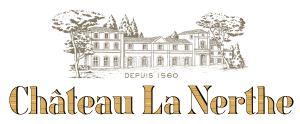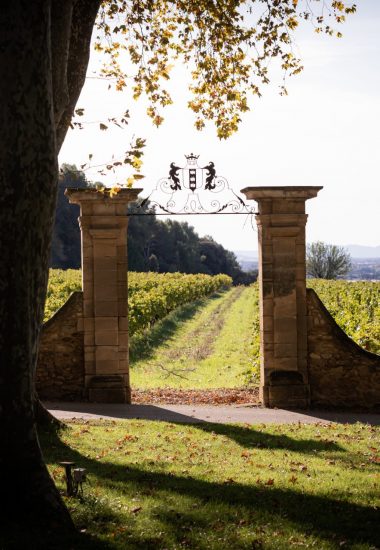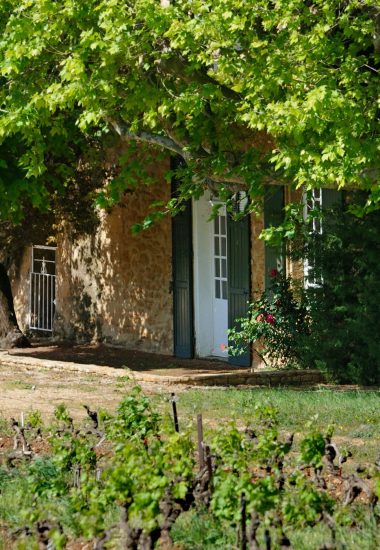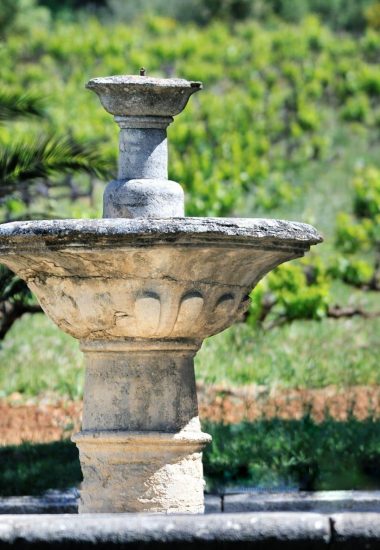
Terroir & Vineyard
The vineyard’s 92 hectares are divided into 57 plots or “climates”. Each of these plots has its own identity due to the unique combination of soils and grape varieties.
Indeed, if the entire vineyard benefits from a typically Mediterranean climate, fortunately tempered by the Mistral, the diversity of the soils and subsoils creates a genuine mosaic of micro-terroirs. To which is added a palette of 13 grape varieties! For five centuries, generations have followed one another at Château La Nerthe to find the perfect match between soil, subsoil, and grape varieties.
The estate has two other valuable allies. First, natural springs flow from each side of the castle. Then, there are the numerous plots of wood and undergrowth, which stretch over nearly 10 hectares. Together, they guarantee the signature freshness of Château La Nerthe wines, as well as the biodiversity of both flora and fauna.
57 Plots, 13 Grape Varieties
At the foot of the Château are the historic vines: Le Clos de Beauvenir and Les Cadettes. Roussanne vines dominate the planted surface of Clos de Beauvenir, complemented by Clairette and Grenache Blanc. The Cadettes cuvée is a blend of the estate’s oldest vines, Grenache, Syrah and Mourvèdre.

Grenache is king on the Crau plateau. Its location is made unique by the rolled pebbles, deep clay, and exposure to the Mistral. Grenache finds its purest expression in the Les Clavelles plot.
The Mourvèdre vines, on the other hand, thrive in soils that are wetter in-depth but just as warm as Grenache. For these reasons, they are in the southern part of la Crau in a hamlet called Escondudes, where there is claystone outcrop.
Syrah is more adaptable and acclimates better to different soils. The warm and stony soils of Cansaud and the sands of la Nerthe suit it perfectly.

Les Cassagnes de La Nerthe
A little further on, at the gates of the charming Provencal village of Uchaux, are our Côtes-du-Rhône and Côtes-du-Rhône Villages “Les Cassagnes de La Nerthe” vines.

The terroir can express all its quintessence because of the exacting standards of the appellation and of Château La Nerthe.

-
Precise and nature-friendly viticulture
Each year, our first task is also the most important: tailored pruning determines what work we will need to do later. Our teams are trained in soft pruning methods, respecting sap flow that we're capable of analyzing.
Throughout the year, we gear tillage and cultivation methods towards more natural practices, respectful of traditions. For example, we use natural plant infusions to strengthen the immune system of the vines.
This return to the past aligns with technical progress that allows us to be more precise and limit our carbon footprint and soil compaction, mainly thanks to lighter equipment which is less harmful to the environment. To better understand our terroirs, we conduct many studies and analyses, particularly on the structure of the soils.
The estate has been farmed organically since 1998, balancing the ecosystem to be more favorable for our practices.
Guided by observation and technique, a great deal of prevention is necessary to combat possible risks for the vines and the environment, often linked to climatic hazards.
-
Precise and nature-friendly viticulture
We have nesting boxes across the domain for chickadees, bats, and owls in our approach to preserving biodiversity. Sheep spend part of the winter on our land eco-grazing. On the flora side, we sew plant cover and plant hedges and fruit trees like fig trees, plums, or even hazelnuts on the estate.
Our philosophy is to favor local essences, increasingly guided by the lunar cycles which punctuate the sowing of plant cover and the planting of new vines.
This sensitivity to nature and respect for its cycles make the difference, allowing the grapes to be healthy at harvest time. Harvesting exclusively by hand enables us to respect each variety's optimal ripeness, one parcel at a time.
Beyond respecting the environment around us, it is a matter of creating sustainably integrated viticulture. We strive to restore an ecosystem from which the vine derives its balance and strength by creating natural spaces for local fauna and flora within the vineyard.
Marine Albert, Vineyard Manager at Château La Nerthe


